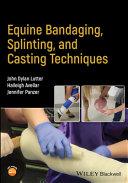Equine Bandaging, Splinting, and Casting Techniques připravuje se

The application of bandages, splints, and casts is an essential part of equine surgical and veterinary care. Traditionally, however, there have been few available resources wholly dedicated to application techniques. The result is that equine veterinary practitioners learn to bandage, splint, and cast on the job, with highly variable results; some practitioners are unwilling even to attempt a cast, spurning this valuable healing tool entirely rather than attempt it from an uncertain base of knowledge.
Equine Bandaging, Splinting, and Casting Techniques offers the first comprehensive reference to this specific set of techniques and their applications in equine veterinary medicine. It promises to cultivate a rigorous, clinically tested, consistent standard of care that will improve patient outcomes and long-term owner costs. It is a must-own for any veterinary practitioner who works with equine patients.
Equine Bandaging, Splinting, and Casting Techniques readers will also find:
Step-by-step organization guides reader smoothly through each process
Practical tips and advice for improving quality and appearance of bandages and casts
Over 270 color images, including clinical examples and radiographs, supplementing every listed technique
Equine Bandaging, Splinting, and Casting Techniques is ideal for all veterinary practitioners, technicians, and students interested in equine care.
Autor: J. Dylan Lutter
| Nakladatel | Wiley-Blackwell |
|---|---|
| ISBN | 9781119841838 |
| Vydání | 2024 |
| Vazba | brožovaná |
| Počet stran | 272 |
The application of bandages, splints, and casts is an essential part of equine surgical and veterinary care. Traditionally, however, there have been few available resources wholly dedicated to application techniques. The result is that equine veterinary practitioners learn to bandage, splint, and cast on the job, with highly variable results; some practitioners are unwilling even to attempt a cast, spurning this valuable healing tool entirely rather than attempt it from an uncertain base of knowledge.
Equine Bandaging, Splinting, and Casting Techniques offers the first comprehensive reference to this specific set of techniques and their applications in equine veterinary medicine. It promises to cultivate a rigorous, clinically tested, consistent standard of care that will improve patient outcomes and long-term owner costs. It is a must-own for any veterinary practitioner who works with equine patients.
Equine Bandaging, Splinting, and Casting Techniques readers will also find:
Step-by-step organization guides reader smoothly through each process
Practical tips and advice for improving quality and appearance of bandages and casts
Over 270 color images, including clinical examples and radiographs, supplementing every listed technique
Equine Bandaging, Splinting, and Casting Techniques is ideal for all veterinary practitioners, technicians, and students interested in equine care.
ABOUT THE AUTHOR
John Dylan Lutter, DVM, MS. DACVS-LA, is a Clinical Assistant Professor in Equine Performance Medicine and Surgery at Kansas State University, College of Veterinary Medicine. He is board certified in large animal surgery since 2015 and has attained a certificate as an Equine Rehabilitation Practioner (Physical Therapy) in 2019.
Haileigh K. Avellar, DVM, MS, DACVS-LA, is a Clinical Assistant Professor in Equine Surgery at Kansas State University, College of Veterinary Medicine. She is board certified in large animal surgery since 2022.
Jennifer M. Panzer, RVT, is a Registered Veterinary Technician in Large Animal and Equine Surgery at Kansas State University, College of Veterinary Medicine. She has been a registered technician since 2001.
TABLE OF CONTENTS
Preface
Section 1: Application of Equine Bandages
1 Materials and Concepts for Bandage Application
Bandage Layers
Primary Layer
Secondary Layer
Tertiary Layer
Additional Protection of the Bandage
Application of Bandage Materials
Order of Application
Amount of Padding
Tension
Wrapping the Material
Applying the Bandage
Preparation for Bandage Application
Safety with the Patient
Sweat Bandages
Special Considerations for Bandage Application
Removing a Bandage
Bandage Management and Complications
Suggested Reading
2 Distal Limb Bandages
Hoof Bandages
Half Limb Bandage
Positioning the Cotton Combine Padding
Applying the Half Limb Bandage
3 Full Limb Bandages
Front Limb
Rear Limb
4 Carpal Bandages
5 Tarsal Bandages
6 Head and Neck Bandages
Ear Bandage
Head Pressure Bandage
Head Netting Bandage
7 Upper Limb and Body Bandages
Elastic Tape/Ether Bandage
Tie-Over Bandage
Abdominal Wrap
Section 2: Application of Equine Limb Splints
8 Materials and Concepts for Splint Application
Principles of Equine Limb Immobilization
Splinting for Wound Healing
Splinting for Flexural Deformities
Splinting for Limb Support and Fractures
Bandages for Splint Application
Robert Jones Bandage
Modified Robert Jones Bandage
Evidence Base for Equine Fracture Splinting
Splint Materials and Fabrication
Fracture First Aid
Fracture Regions
References
Suggested Reading
9 Distal Limb Splinting
Region I PVC Splinting – Phalanges and Distal Fetlock
10 Full Limb Splinting
Region II PVC Splinting – Metacarpus/Metatarsus and Carpus/Tarsus
Region III PVC Splinting – Radius, Ulna, and Tibia
Section 3: Application of Equine Casts
11 Materials and Concepts for Cast Application
Casting Team
Patient Preparation for Cast Application
Limb Positioning for Cast Application
Cast Materials and Method of Application
Stockinette
Cast Padding
Cast Tape
Cast Management and Complications
Cast Removal
Suggested Reading
12 Hoof and Phalangeal Casts
Hoof Cast
Phalangeal Cast
13 Bandage Casts
14 Half Limb Casts
15 Full Limb Casts
Index